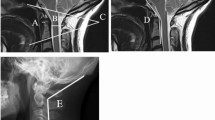Summary.
Background: The aim of the study was to evaluate the effectiveness, pitfalls and failures of instrumentation and fusion with titanium wires and rods in 12 h patients with craniovertebral junction instability.
Methods: Among nine adult patients (mean age 48.11 years) with craniovertebral junction instability, four had basilar impression, three metastatic disease, one rheumatoid arthritis and one Down's syndrome. Three children (mean age 7.33 years) with genetic (Down's syndrome, 2 cases) and metabolic (mucopolisaccarydoses type IV, i.e. Morquio Syndrome, 1 case) disease were studied as well. Each patient underwent preoperative radiological evaluation by means of X-Ray, CT scan and MRI of the craniocervical region. Occipitocervical instrumentation with a titanium U-shaped wired rod was performed in each patient. Autologous bone fusion was performed in all but the two cancer patients, in whom polymethylmetacrylate was used. Postoperatively, all the patients used an external orthosis for 3–6 months. Post-operative X-Ray, CT and MRI were performed on each patient. The Frankel clinical scale was used to asses the outcome at follow-up which ranged from 1 to 10 years. At maximum follow up, there was either clinical improvement or stabilization recorded in all but one patient. This patient with basilar impression transiently worsened from grade D to C and a spinal cord lesion was already evident before the operation on MRI examination.
Interpretation: The effectiveness of surgical management of craniovertebral junction instability by instrumentation and fusion was demonstratedly in our experience. Nevertheless, the choice of the surgical technique should be made with caution when a spinal cord lesion is revealed by preoperative neuroimaging studies.
Similar content being viewed by others
Author information
Authors and Affiliations
Additional information
Published online April 28, 2003
Acknowledgments We thank MS. Ciara Harraher for editorial assistance.
Correspondence: Visocchi Massimiliano MD, Institute of Neurosurgery, Catholic University of “Sacred Heart”, Lgo. A. Gemelli, 8, 00168 Rome, Italy.
Rights and permissions
About this article
Cite this article
Visocchi, M., Di Rocco, F. & Meglio, M. Craniocervical junction instability: instrumentation and fusion with titanium rods and sublaminar wires. Effectiveness and failures in personal experience. Acta Neurochir (Wien) 145, 265–272 (2003). https://doi.org/10.1007/s00701-002-1067-6
Issue Date:
DOI: https://doi.org/10.1007/s00701-002-1067-6




